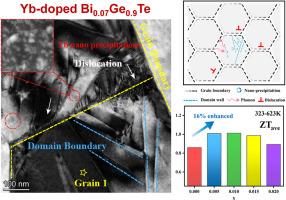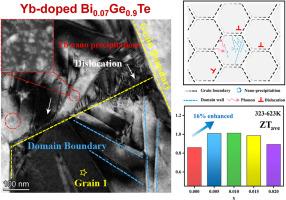镱铋共掺杂增强菱形GeTe的热电性能
IF 9.7
2区 材料科学
Q1 MATERIALS SCIENCE, MULTIDISCIPLINARY
引用次数: 0
摘要
gete基材料有望用于中温能量转换,但其实际应用受到相变的限制,相变会降低热电性能和机械稳定性。本文介绍了一种稳定GeTe晶格结构和提高热电效率的新型掺杂策略。Yb掺杂增强了价带最大值处的能带简并度,从而增加了空穴的有效质量,最终导致塞贝克系数升高。Yb- bi共掺杂与快速凝固过程的结合具有两个主要功能:(i)提高了Yb在GeTe基体中的均匀性;(ii)促进了纳米级富Yb二次相的形成。由此产生的缺陷结构以晶粒细化、纳米沉淀、畴边界和密集的位错网络为特征,加剧了声子散射。结果,在yb0.010 bi0.07 ge0.9 te中实现了热电参数的解耦,功率因数增加,导热系数降低,低于623K。最后,与Bi单掺杂样品相比,Yb0.005Bi0.07Ge0.9Te和Yb0.010Bi0.07Ge0.9Te中ZTave (323-623K)增强了16%。结果表明,在Bi0.07Ge0.9Te中掺杂稀镱的好处,是先进可持续能源应用的理想选择。本文章由计算机程序翻译,如有差异,请以英文原文为准。


Enhanced thermoelectric performance of rhombohedral GeTe by Yb-Bi Co-doping
GeTe-based materials are promising for medium-temperature energy conversion, but its practical use is limited by the phase transition, which deteriorates both thermoelectric performance and mechanical stability. This work introduces a novel doping strategy to stabilize the GeTe lattice structure and enhance thermoelectric efficiency. Yb doping enhances the band degeneracy at the valence band maximum, which in turn increases the effective mass of holes, ultimately leading to an elevated Seebeck coefficient. The combination of Yb-Bi co-doping and rapid solidification process is concluded to be of two main functions: (i) increasing the homogeneity of Yb in GeTe matrix, and (ii) facilitating the formation of nano-sized Yb-rich secondary phases. The resulting defect structure, characterized by refined grains, nanoprecipitates, domain boundary and dense dislocation networks, intensifies phonon scattering. As a result, a decoupling of thermoelectric parameters was achieved in Yb0.010Bi0.07Ge0.9Te—with increased power factor and decreased thermal conductivity, below 623K. Finally, compared with Bi monodoping sample, a 16 % enhancement of ZTave (323–623K) was obtained in Yb0.005Bi0.07Ge0.9Te and Yb0.010Bi0.07Ge0.9Te. The results demonstrate the benefits of dilute Yb doping in Bi0.07Ge0.9Te, which is ideal for advanced sustainable energy applications.
求助全文
通过发布文献求助,成功后即可免费获取论文全文。
去求助
来源期刊

Materials Today Physics
Materials Science-General Materials Science
CiteScore
14.00
自引率
7.80%
发文量
284
审稿时长
15 days
期刊介绍:
Materials Today Physics is a multi-disciplinary journal focused on the physics of materials, encompassing both the physical properties and materials synthesis. Operating at the interface of physics and materials science, this journal covers one of the largest and most dynamic fields within physical science. The forefront research in materials physics is driving advancements in new materials, uncovering new physics, and fostering novel applications at an unprecedented pace.
 求助内容:
求助内容: 应助结果提醒方式:
应助结果提醒方式:


